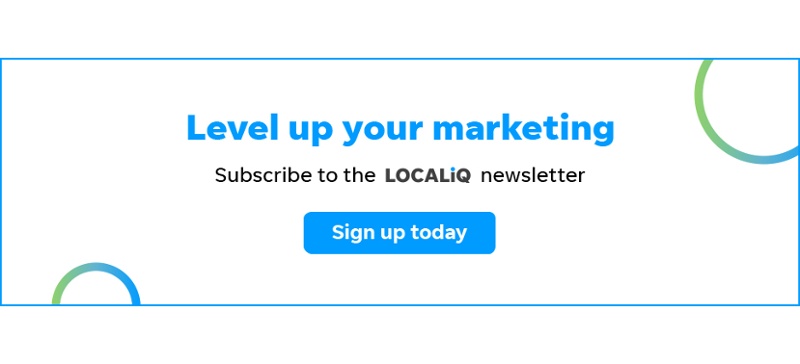Do you feel like everyone is talking in code when it comes to marketing? Sentences are littered with acronyms, and it feels new ones are introduced each week. It can be difficult navigating the marketing landscape, so LOCALiQ has put together some of the most commonly used acronyms with a brief description of each one to help you become confident in using and understanding these acronyms.
A-Z of Marketing
A
AIDA (Attention, Interest, Desire, Action)
AIDA is a purchasing funnel where a customer moves from interest to action (e.g., purchasing a product or service). While AIDA is still used, it is becoming more outdated as AIDA does not consider factors such as re-purchasing, customers advocating the product/service.
B
B2B (Business to Business)
Communications and sales between businesses
B2C (Business to Customer)
Communications and sales between a business and a customer
BR (Bounce Rate)
Percentage of people landing on a page on your website and leaving without following a CTA or visiting another page on your website.
C
CMS (Content Management System)
A system that works behind the scenes allows businesses to create, edit, and manage their website.
CPA (Cost per Action)
An advertiser pays every time someone performs an action, such as clicking on your website, making a purchase or it could be an impression.
CPC (Cost per Click)
The cost is paid every time a user clicks on your link in a paid ad.
CPL (Cost per Lead)
The amount it costs to acquire a lead.
CR (Conversion Rate)
The number of people who complete an action on your website against those that did not.
CTA (Call to Action)
A CTA is a button that entices a user to sign up, subscribe, like, or follow you or your business.
CTR (Clickthrough Rate)
The number of clicks is rated against the number of impressions.
D
DA (Domain Authority)
Refers to a search engine ranking score and can affect how far up a website appears in SERPs.
E
EAT (Expertise, Authoritativeness, Trustworthiness)
How a search engine assesses a webpage. This is linked very closely with SEO.
G
GA (Google Analytics)
Google Analytics is a free service provided by Google, that provides detailed statistics about a website’s traffic, conversions, sales and so much more.
GMB (Google my Business)
Want to be found easily on the Google Map feature? We even have a guide to getting started with GMB.
K
KPI (Key Performance Indicator)
A KPI is how a business measures its successes.
M
Mktg (Marketing)
You may see marketing abbreviated to Mktg online.
MoM (Month on Month)
The changes are reported month on month within a business.
N
NAP (Name, Address, Phone Number)
Unfortunately, not a command to go and have a little sleep but an acronym for someone’s name, address, and phone number!
P
PPC (Pay per Click)
A paid-for ad that appears above and below organic search results on a SERP. A business is charged every time someone clicks on that ad.
R
ROI (Return on Investment)
Are you getting your money’s worth from a campaign? This is the profit/loss from a particular campaign.
S
SEO (Search Engine Optimisation)
SEO is a way to build organic traffic to your website and having your website be on page 1 of a Search Engine
SEM (Search Engine Marketing)
Search Engine Marketing covers both SEO and PPC marketing.
SERPs (Search Engine Results Pages)
The list of results from a search from you inputted to a search engine (e.g., Google/Bing/Yahoo)
SM (Social Media)
Social networking sites such as Facebook, Instagram, Tik Tok, Snapchat, Twitter, LinkedIn.
SMART (Specific, Measurable, Achievable, Time-bound, Realistic)
SMART goals are one of the best ways to set goals and targets for your business
SMM (Social Media Marketing)
SMM is the art of using social media to market your goods and services to potential customers using Social Media.
T
TL;DR (Too Long; Didn’t Read)
Commonly used on forums, TL;DR is a summary of a very long text-based article/document
U
UGC (User Generated Content)
UGC is seen as authentic and truthful content, this content has been produced by your users and followers that promote your company. This can be a variety of formats, unboxing a product, using a product, blogging, images, video, etc.
USP (Unique Selling Proposition/Point)
Your USP is what makes YOU stand out from everyone else.
UX (User Experience)
The overall experience a customer has with the business. UX is commonly used in website experience, is the website user-friendly?
W
WOM (Word of Mouth)
A traditional form of marketing where a person talked about your product or service, now used online in reviews and UGC.
Y
YoY (Year on Year)
A comparison between this year and the previous year(s).
Related Blogs:
Are PPC and Search Marketing the Same? Not just acronyms but also common phrases and words you will hear often in Marketing.
If you found this useful, then why not sign up to our newsletter to get our monthly newsletter direct to your inbox that is full of useful and insightful digital marketing news?






